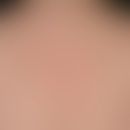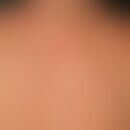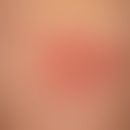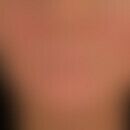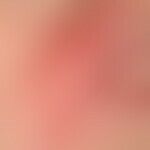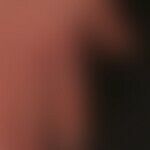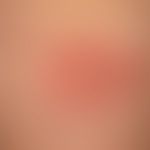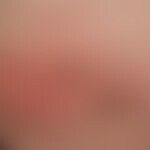Synonym(s)
DefinitionThis section has been translated automatically.
Frequent, acute, less frequently chronically recurrent, febrile, possibly accompanied by chills, non-pathogenic, usually asymmetric (exception facial serysipele, see Fig.), bacterial infection of the skin that can spread rapidly lymphogenically.
PathogenThis section has been translated automatically.
Beta-hemolytic streptococci of group A, as well as representatives of groups B, C, and G. Recent studies indicate that in bullous erysipelas and in necrotizing forms, staphylococci (Staphylococcus aureus) and, very rarely, pneumococci (especially in immunocompromised patients) may also play a pathogenetic role (Bachmeyer C et al. 2012), see also MRSA).
Gram-negative pathogens (e.g., E. coli, Pseudomonas aeruginosa) can also play a pathogenetic role in rare cases, especially in immunosuppressed patients.
You might also be interested in
Occurrence/EpidemiologyThis section has been translated automatically.
There are contradictory data on the incidences:
Incidence: 100/100,000 persons/year.
According to an American study (Ren Z et al. 2021), the incidence:
- for adults: 2.42 to 3.55/1,000,000
- and for children: 1.14 to 2.09/1.000.000
EtiopathogenesisThis section has been translated automatically.
Penetration of streptococci through barrier-disrupted skin areas into cutaneous lymphatic ducts (often after tinea pedum or minor mechanical trauma; "erysipelas"). Persistent lymphedema, including erosions due to focal desiccation of the skin, are pathogens for infection (e.g., edema after long-stretch saphenectomy for bypass surgery).
PathophysiologyThis section has been translated automatically.
Pathophysiologically, there is an open port of entry. Common ports of entry are athlete's foot, rhagades, ulcers, puncture sites or erosions. Entry through the portal allows the bacteria to enter the lymphatic vessels, and from here the bacteria can spread and cause inflammation of the skin.
ManifestationThis section has been translated automatically.
Preferably adults between the ages of 20 and 70 . Lj. In larger studies the average age is about 50 years. Children and adolescents are less frequently affected.
LocalizationThis section has been translated automatically.
The possible entry sites determine the predilection sites (mainly face and lower leg), whereby there is usually a certain distance between erysipelas and the entry site.
- Extremities:
- Lower leg (about 70% of cases)
- Forearms (about 12% of cases)
- Face (about 13% of cases): mainly cheek area, nasal entrance in rhinitis. (DD: dermatomyositis; systemic lupus erythematosus, rosacea).
- Trunk (about 3% of cases).
Note: a major source as a reservoir of germs is the nasopharynx of the affected persons themselves (germ carriers of Str. pyogenes are 20-30% of young eadults - Nayak N et al. 2016).
Clinical featuresThis section has been translated automatically.
Mostly asymmetric, acute painful, rapidly spreading, edematous dermatitis with sharply delimited, areal, marginally also finger-shaped configured, intense, surface-smooth redness. The affected area is markedly hyperthermic and clearly painful on palpation. If left untreated, rapid lymphogenic spread of dermal inflammation occurs.
The acute infection is accompanied by chills, fever (up to 40 °C), painful lymphangitis and lymphadenitis. Not infrequently, complicating vesicles and hemorrhagic blistering may occur (erysipelas vesiculosum et bullosum).
LaboratoryThis section has been translated automatically.
Leukocytosis with neutrophilia, BSG and CRP elevation. ASL and anti-streptodornase B(ABD) titers elevated.
HistologyThis section has been translated automatically.
DiagnosisThis section has been translated automatically.
Differential diagnosisThis section has been translated automatically.
Clinical:
- acute dermatitis (no fever, no lymphadenitis, itching)
- initial zoster (important in differentiation from facial serysipelas; pain often predominant, no fever, no painful lymphadenitis, later pathological segmental spread with vesicle or blister formation)
- superficial thrombophlebitis (cord-like induration, fever usually absent)
- lymphangitis acuta (characteristic linear redness along a lymphatic pathway)
- Erysipelas carcinomatosum (usually board-like infiltration, acuity absent)
- Erysipeloid (infection proceeds blandly, localization - hands)
- Angioedema (no fever, no lymphadenitis)
- Facial erysipelas
- Rosacea erythematosa (chronic condition, no fever, alternating redness and swelling)
- Dermatomyositis/SLE(severe chronic condition with adynamia and signs of autoimmunologic disease)
- Acute dermatitis (contact history detectable, acute within a few hours; vesicular dermatitis)
- Angioedema (acute swelling, no fever, no lymphangitis, no pain)
- Phlegmon
- Thrombophlebitis
- Erythema nodosum (highly painful plaques and nodules, usually no extensive redness)
- Stasis dermatitis (in contrast to erysipelas, fever and pain are absent here)
- Contact dermatitis (itchy erythema or plaques , in contrast to erysipelas always without fever)
- Erysipelas-like cutaneous leishmaniasis (vacation trip; slow onset, no fever, no lymphadenitis, persisting for months, antibiotic resistance).
Histologic:
- Erysipeloid (cannot be distinguished from erysipelas; complicative components absent);
- Acute febrile neutrophilic dermatosis (diffuse, very dense, neutrophilic dermis infiltration, hemorrhages absent; clinical picture to be considered);
- Light dermatosis, polymorphous (vigorous dermal edema, no neutrophilia, epidermis mostly spongiotic).
Complication(s)This section has been translated automatically.
A hemorrhagic component may be considered an exacerbation of the infection.
Blistering with very exudative inflammatory reaction: see below Erysipelas bullous.
Phlegmonous: see below. Erysipelas phlegmonous (fuzzy collections of pus along the anatomical guide rails).
Gangrenous erysipelas (Erysipelas gangraenosum): dreaded necrotizing course.
Necrotizing fasciitis as a severe, rapidly progressive, life-threatening soft tissue infection.
Septic erysipelas: sepsis with endocarditis and possibly glomerulonephritis (<5%) originating from the erysipelas of the skin.
Facial erysipelas: particularly feared erysipelas variant especially when the erysipelas starts above the nasal saddle. In this case, spread to the orbita is possible.
Erysipelas recurrence (see below Erysipelas, recurrent): Recurrences are observed within 6 months in 10% of cases (30% within 3 years).
Chronic recurrent erysipelas: Recurrent erysipelas is preferentially observed in patients with co-morbidities including hypertension, obesity, CVI, and diabetes (Li A et al 2021). Recurrent erysipelas carries the risk of secondary lymphedema with all the possible sequelae that may result(papillomatosis cutis lymphostatica, macrocheilia).
Streptococcal allergic systemic sequelae: acute streptococcal glomerulonephritis .
TherapyThis section has been translated automatically.
Systemic antibiosis see table 1.
Heparinization during bed rest. Antipyretic and, if necessary, analgesic measures with paracetamol (e.g. Ben-u-ron Tbl.) 3 times/day 500-1000 mg p.o.
In case of persistent swelling, manual and, if necessary, additional intermittent lymphatic drainage with apparatus from the 3rd-5th day after antibiosis.
Notice! No lymphatic drainage in acute inflammation! Germs are spread!
In case of recurrent erysipelas, treatment of acute symptoms, followed by regular penicillin cycles and lymphedema treatment for 1 year.
S.u. Erysipelas, recurrent.
General therapyThis section has been translated automatically.
Bed rest, cooling and elevation of the affected body part. After the acute inflammatory reaction has subsided, lymph drainage can be supportive. In the case of facial erysipelas, speaking is forbidden and the indication for passed fare exists.
External therapyThis section has been translated automatically.
Progression/forecastThis section has been translated automatically.
Favorable under sufficient antibiotic therapy. In case of predisposition (untreated tinea, lymphedema, chronic venous insufficiency), there is a risk of recurrence, usually in the same localization. Accordingly, an existing underlying disease must be treated as well.
Another possible cause of recurrence is intracellular uptake and persistence of streptococci. Because β-lactam antibiotics reach bactericidal concentrations only in the extracellular space, it may require the additional use of intracellularly active antibiotics, such as clindamycin, macrolides, and rifampicin. The combination of clindamycin or rifampicin together with penicillin currently proves to be the most effective combination for the treatment of infections with group A streptococci (see also erysipelas, recurrent).
TablesThis section has been translated automatically.
System therapy in erysipelas
|
Drug substance and example preparation |
Dose |
Duration of therapy |
Uncomplicated course |
Penicillin V (e.g. Megacillin) |
1.5-3 million IU/day p.o. in 3-4 EDs |
10 days |
Complicated course or chronic relapse |
Penicillin G (e.g. Penicillin Grünenthal) if necessary in combination with clindamycin |
15-30 million IU/day i.v. in 3-4 ED (max. 30 mega/day) 3 times/day 600 mg i.v. |
until healing |
Complicated course/penicillin allergy |
Vancomycin |
40-60 mg/kg/day in 2-3 ED |
until healing |
Mixed infections |
Oxacillin (e.g. Infectostaph) |
4 times/day 1 g (max. 8 g) i.v. or i.m. |
10 days |
Cephalosporins such as cefotaxime (e.g. Claforan) |
2-3 times/day 2 g i.v. |
Until healing |
|
Combination of cefuroxime (e.g., Cefuroxime Hexal) + gentamicin (e.g., Refobacin) |
2 times/day 1.5 g i.v. + 240 mg/day i.v. |
Until healing |
|
Penicillin allergy |
Erythromycin (e.g. Erythrocin) |
4 times/day 0.5-1 g p.o. |
10 days
7-10 days |
|
Clarithromycin (e.g. Klacid) Clindamycin |
2 times/day 250-500 mg p.o. 3 times/day 600 mg p.o./i.v. |
LiteratureThis section has been translated automatically.
- Bachmeyer C et al. (2012) Érysipèle à Streptococcus pneumoniae révélateur d'une infection par le virus de l'immunodéficience humaine. Press Med 41:883-884.
- Brennecke S, Hartmann M, Schofer H, Rasokat H, Tschachler E, Brockmeyer NH (2005) Treatment of erysipelas in Germany and Austria--results of a survey in German and Austrian dermatological clinics. J Dtsch Dermatol Ges 3: 263-270
- Hadzovic-Cengic M et al.(2012) Cellulitis--epidemiological and clinical characteristics. Med Arch 66(3 Suppl 1):51-53
- Krasagakis K et al. (2006) Bullous erysipelas: clinical presentation, staphylococcal involvement and methicillin resistance. Dermatology 212: 31-35
- Li A et al (2021) Risk factors of recurrent erysipelas in adult Chinese patients: a prospective cohort study. BMC Infect Dis 21:26.
- Nayak N et al (2016) Clinical implications of microbial biofilms in chronic rhinosinusitis and orbital cellulitis.BMC Ophthalmol 16:165.
Parajuli N et al (2020) Case Report: Erysipeloid Cutaneous Leishmaniasis Treated with Oral Miltefosine. Am J Trop Med Hyg 104:643-645.
- Ren Z et al (2021) Burden, risk factors, and infectious complications of cellulitis and erysipelas in US adults and children in the emergency department setting. J Am Acad Dermatol 84:1496-1503.
- Schwartz MN (2004) Cellulitis. N Eng J Med 350: 904-912.
- Segnitz A et al (2010) Afebrile erysipelas under etanercept. Akt Dermatol 35: 444-446
- Sunderkotter C, Herrmann M, Jappe U (2006) Antimicrobial therapy in dermatology. J Dtsch Dermatol Ges 4: 10-27.
Incoming links (57)
Angioedema histamine-mediated; Blepharitis; Candidosis, interdigital; Cellulite; Compression pneumatic intermittent; Compression, pneumatic intermittent; Dermatoliposclerosis; Ekthyma; Elephantiasis syphilitica; Eosinophilic cellulitis ; ... Show allOutgoing links (33)
Angioedema (overview); Antibiotics; Dermatitis; Dermatomyositis (overview); Endocarditis, bacterial; Erysipelas; Erysipelas bullous; Erysipelas carcinomatosum; Erysipeloid; Escherichia coli; ... Show allDisclaimer
Please ask your physician for a reliable diagnosis. This website is only meant as a reference.
